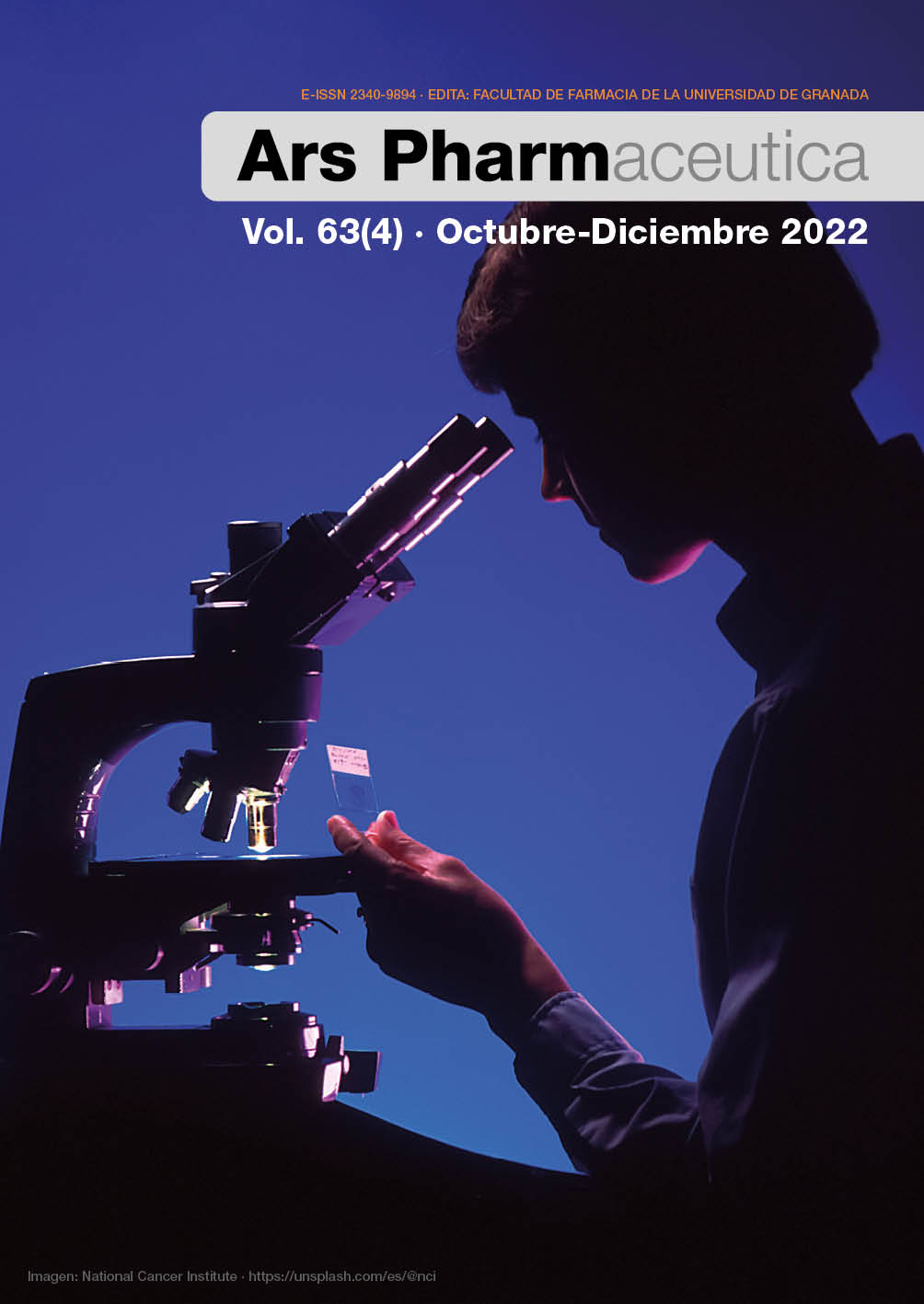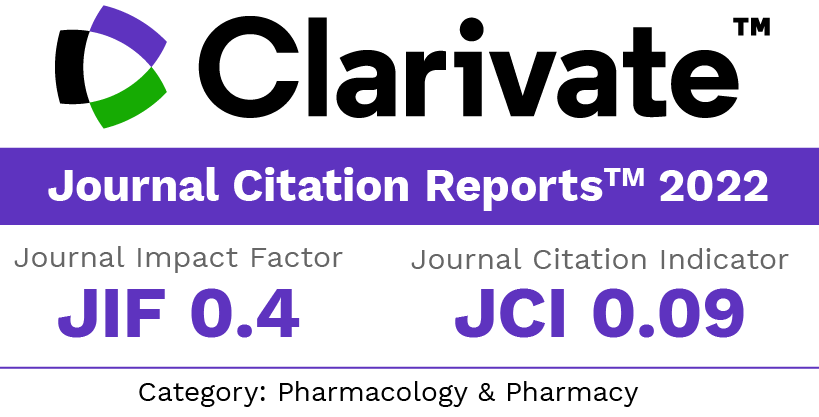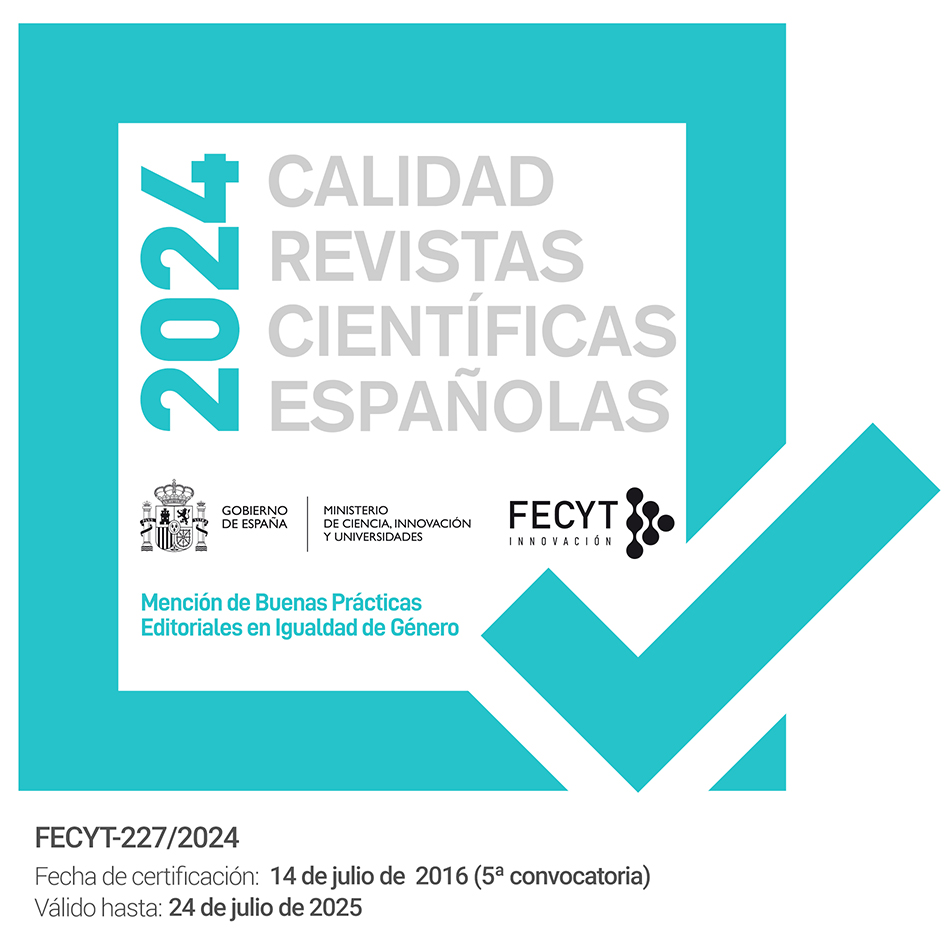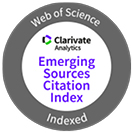Momordica charantia extract modulates inflammatory response in human lymphocytes via suppression of TNF-α
DOI:
https://doi.org/10.30827/ars.v63i4.24256Keywords:
Bitter melon, cytotoxicity, genotoxicity, mutagenicity, inflammatory parametersAbstract
Introducción: Momordica charantia L. es ampliamente utilizada para consumo y medicina tradicional debido a sus actividades biológicas. Sin embargo, se sabe poco sobre los efectos del melón amargo en las células sanas. Por lo tanto, nuestro objetivo fue evaluar los efectos del extracto de Momordica charantia en linfocitos humanos aislados, especialmente en aspectos inflamatorios, citotóxicos, genotóxicos y mutagénicos.
Método: Para ello se preparó un extracto hidroetanólico con frutos y semillas y se procedió a la identificación y cuantificación fitoquímica. Los linfocitos humanos purificados se expusieron a 12,5, 25 y 50 µg/mL de extracto de Momordica charantia durante 24 horas y después de este período.
Resultados: Los datos mostraron que el extracto de Momordica charantia no indujo citotoxicidad, alteraciones en la frecuencia de micronúcleos, ni actividad de interleucina-6, interleucina-10 ciclooxigenasa-2 y producción de óxido nítrico; sin embargo, causó daño en el ADN y una disminución de TNF-α en las condiciones experimentales y células aplicadas.
Conclusiones: Nuestros datos proponen un proceso antiinflamatorio generado por Momordica charantia mediado por la reducción de TNF-α.
Downloads
References
Jia S, Shen M, Zhang F, Xie J. Recent advances in Momordica charantia: functional components and biological activities. Int J Mol Sci. 2017;18(12):2555. Doi: 10.3390/ijms18122555.
Anilakumar KR, Kumar GP, Ilaiyaraja N. Nutritional, pharmacological and medicinal properties of Momordica charantia. International J Nut Food Sci. 2015;4(1):75-83. doi: 10.11648/j.ijnfs.20150401.21
Grover J, Yadav S. Pharmacological actions and potential uses of Momordica charantia: a review. J Ethnopharmacol. 2004;93(1):123-32. Doi: 10.1016/j.jep.2004.03.035
Kumar KS, Bhowmik D. Traditional medicinal uses and therapeutic benefits of Momordica charantia Linn. Int J Phar Sci Rev Res. 2010;4(3):23-8. ISSN 0976 – 044X
Bortolotti M, Mercatelli D, Polito L. Momordica charantia, a nutraceutical approach for inflammatory related diseases. Front Pharmacol. 2019;10:486. Doi: 10.3389/fphar.2019.00486
Kwatra D, Dandawate P, Padhye S, Anant S. Bitter melon as a therapy for diabetes, inflammation, and cancer: a panacea? Curr Pharmacol Rep. 2016;2(1):34-44. Doi: 10.1007/s40495-016-0045-2
Laghari AH, Memon S, Nelofar A, Khan KM, Yasmin A. Determination of free phenolic acids and antioxidant activity of methanolic extracts obtained from fruits and leaves of Chenopodium album. Food Chem. 2011;126(4):1850-5. Doi: 10.1016/j.foodchem.2010.11.165
Co-operation OfE, Development. Test No. 487: In vitro mammalian cell micronucleus test: OECD Publishing; 2016.
de Moura Leão MF, Duarte JA, Sauzen PD, Piccoli JdCE, de Oliveira LFS, Machado MM. Cytotoxic and genotoxic effects of antihypertensives distributed in Brazil by social programs: Are they safe? Environ Toxicol Pharmacol.. 2018;63:1-5. Doi: 10.1016/j.etap.2018.08.005
Pasqualli T, E Chaves PE, da Veiga Pereira L, Adílio Serpa É, de Oliveira LFS, Machado MMJC, et al. Sucralose causes non-selective CD4 and CD8 lymphotoxicity via probable regulation of the MAPK8/APTX/EID1 genes: An in vitro/in silico study. Clin Exp Pharmacol Physiol. 2020;47(10):1751-7. Doi: 10.1111/1440-1681.13362
Schmid W. The micronucleus test. Mutat Res Environ Mutagen Relat Subj. 1975;31(1):9-15. Doi: 10.1007/978-1-4684-0892-8_2
Singh NP, McCoy MT, Tice RR, Schneider EL. A simple technique for quantitation of low levels of DNA damage in individual cells. Exp Cell Res. 1988;175(1):184-91. Doi: 10.1016/0014-4827(88)90265-0
Tice RR, Agurell E, Anderson D, Burlinson B, Hartmann A, Kobayashi H, et al. Single cell gel/comet assay: guidelines for in vitro and in vivo genetic toxicology testing. Environ Mol Mutagen. 2000;35(3):206-21. Doi: 10.1002/(SICI)1098-2280(2000)35:3<206::AID-EM8>3.0.CO;2-J
Dandawate PR, Subramaniam D, Padhye SB, Anant S. Bitter melon: a panacea for inflammation and cancer. Chin J Nat Med. 2016;14(2):81-100. Doi: 10.1016/S1875-5364(16)60002-X
Zhang F, Lin L, Xie J. A mini-review of chemical and biological properties of polysaccharides from Momordica charantia. Int J Biol Macromol. 2016;92:246-53. Doi: 10.1016/j.ijbiomac.2016.06.101
Kubola J, Siriamornpun S. Phenolic contents and antioxidant activities of bitter gourd (Momordica charantia L.) leaf, stem and fruit fraction extracts in vitro. Food chem. 2008;110(4):881-90. Doi:10.1016/j.foodchem.2008.02.076
Horax R, Hettiarachchy N, Chen P. Extraction, quantification, and antioxidant activities of phenolics from pericarp and seeds of bitter melons (Momordica charantia) harvested at three maturity stages (immature, mature, and ripe). J Agric Food Chem. 2010;58(7):4428-33. Doi: 10.1021/jf9029578
Pereira CA, Oliveira LL, Coaglio AL, Santos FS, Cezar RS, Mendes T, et al. Anti-helminthic activity of Momordica charantia L. against Fasciola hepatica eggs after twelve days of incubation in vitro. Vet parasitol. 2016;228:160-6. Doi:10.1016/j.vetpar.2016.08.025
Supe U, Daniel P. Preliminary phytochemical analysis and quantitative analysis of Quercetin by HPLC of Momordica charantia. World J Pharm Res. 2014;4(01):848-53. ISSN 2277– 7105
Sathasivam R, Park CH, Yeo HJ, Park YE, Kim JK, Park SU. Analysis of triterpenoids, carotenoids, and phenylpropanoids in the flowers, leaves, roots, and stems of white bitter melon (Cucurbitaceae, Momordica charantia). Trop J Pharm Res. 2021;20(1):155-60. Doi: 10.4314/tjpr.v20i1.22
Ray RB, Raychoudhuri A, Steele R, Nerurkar P. Bitter melon (Momordica charantia) extract inhibits breast cancer cell proliferation by modulating cell cycle regulatory genes and promotes apoptosis. Cancer Res. 2010;70(5):1925-31. Doi: 10.1158/0008-5472.CAN-09-3438
Agrawal R, Beohar T. Chemopreventive and anticarcinogenic effects of Momordica charantia extract. Asian Pacific J Cancer Prev. 2010;11(2):371-5. ISSN 1513-7368.
Birla D, Sonali K, Shaikh A, Khan A, Ghosi A, Pardeshi P. Evaluation of antimutagenic activity of methanolic extract of leaves of Momordica charantia Linn. Int J Health Med. 2017;5:81-3. ISSN: 2321-2187
Sumanth M, Chowdary GN. Antimutagenic activity of aqueous extract of Momordica charantia. Int J of Biotechnol and Mol Bio Res. 2010;1(4):42-6. ISSN 2141-2154
Lii C-K, Chen H-W, Yun W-T, Liu K-L. Suppressive effects of wild bitter gourd (Momordica charantia Linn. var. abbreviata ser.) fruit extracts on inflammatory responses in RAW 264.7 macrophages. J of Ethnopharmacol. 2009;122(2):227-33. Doi: 10.1016/j.jep.2009.01.028
Ganguly C, De S, Das S. Prevention of carcinogen-induced mouse skin papilloma by whole fruit aqueous extract of Momordica charantia. Eur J of Cancer Prev. 2000:283-8. Doi: 10.1097/00008469-200008000-00009
Li C-J, Tsang S-F, Tsai C-H, Tsai H-Y, Chyuan J-H, Hsu H-Y. Momordica charantia extract induces apoptosis in human cancer cells through caspase-and mitochondria-dependent pathways. Evid Based Complem and Altern Med. 2012;2012. Doi:10.1155/2012/261971
Tanaka T, Narazaki M, Kishimoto T. IL-6 in inflammation, immunity, and disease. Cold Spring Harb Perspect Biol. 2014;6(10):a016295. Doi: 10.1101/cshperspect.a016295
Cao TQ, Phong NV, Kim JH, Gao D, Anh HLT, Ngo V-D, et al. Inhibitory Effects of Cucurbitane-Type Triterpenoids from Momordica charantia Fruit on Lipopolysaccharide-Stimulated Pro-Inflammatory Cytokine Production in Bone Marrow-Derived Dendritic Cells. Molecules. 2021;26(15):4444. Doi: 10.3390/molecules26154444
Bao B, Chen Y-G, Zhang L, Na Xu YL, Wang X, Liu J, et al. Momordica charantia (Bitter Melon) reduces obesity-associated macrophage and mast cell infiltration as well as inflammatory cytokine expression in adipose tissues. PloS one. 2013;8(12):e84075. Doi: 10.1371/journal.pone.0084075
Fachinan R, Yessoufou A, Nekoua MP, Moutairou K. Effectiveness of antihyperglycemic effect of Momordica charantia: implication of t-cell cytokines. Evid Based Complem and Altern Med.2017;2017. Doi: 10.1155/2017/3707046
Ünal NG, Kozak A, Karakaya S, Oruç N, Barutçuoğlu B, Aktan Ç, et al. Anti-inflammatory effect of crude Momordica charantia l. extract on 2, 4, 6-trinitrobenzene sulfonic acid-induced colitis model in rat and the bioaccessibility of its carotenoid content. J Med Food. 2020;23(6):641-8. Doi: 10.1089/jmf.2019.0124
Chao C-Y, Sung P-J, Wang W-H, Kuo Y-H. Anti-inflammatory effect of Momordica charantia in sepsis mice. Molecules. 2014;19(8):12777-88. Doi: 10.3390/molecules190812777
Ali MM, Borai IH, Ghanem HM, Abdel-Halim AH, Mousa FM. The prophylactic and therapeutic effects of Momordica charantia methanol extract through controlling different hallmarks of the hepatocarcinogenesis. Biomed & Pharmacother. 2018;98:491-8. Doi: 10.1016/j.biopha.2017.12.096
Yang WS, Yang E, Kim M-J, Jeong D, Yoon DH, Sung G-H, et al. Momordica charantia inhibits inflammatory responses in murine macrophages via suppression of TAK1. Am J Chin Med. 2018;46(02):435-52. Doi: 10.1142/S0192415X18500222
Dwijayanti DR, Okuyama T, Okumura T, Ikeya Y, Nishizawa M. The anti-inflammatory effects of Indonesian and Japanese bitter melon (Momordica charantia L.) fruit extracts on interleukin-1β-treated hepatocytes. Funct Foods in Health and Dis. 2019;9(1):16-33. Doi: 10.31989/ffhd.v9i1.560
Zelová H, Hošek J. TNF-α signalling and inflammation: interactions between old acquaintances. Inflammation Res. 2013;62(7):641-51. Doi: 10.1007/s00011-013-0633-0
Lee SY, Wong WF, Dong J, Cheng K-K. Momordica charantia suppresses inflammation and glycolysis in lipopolysaccharide-activated RAW264. 7 macrophages. Molecules. 2020;25(17):3783. Doi: 10.3390/molecules25173783
Cheng H-L, Kuo C-Y, Liao Y-W, Lin C-C. EMCD, a hypoglycemic triterpene isolated from Momordica charantia wild variant, attenuates TNF-α-induced inflammation in FL83B cells in an AMP-activated protein kinase-independent manner. Eur J Pharmacol. 2012;689(1-3):241-8. Doi: 10.1016/j.ejphar.2012.05.033
Published
How to Cite
Issue
Section
License
Copyright (c) 2022 Paula Fischer , Gabriela Cristiane Mendes Gomes , Bibiana Frasson Etcheverry , Nathália Vieira Rios , Pamella Eduardha Espindola Chaves , Emily Clori Sotelo , Dyene Nascimento Campos , Luísa Zuravski , Taiane Acunha Escobar , Michel Mansur Machado

This work is licensed under a Creative Commons Attribution-NonCommercial-ShareAlike 4.0 International License.
The articles, which are published in this journal, are subject to the following terms in relation to the rights of patrimonial or exploitation:
- The authors will keep their copyright and guarantee to the journal the right of first publication of their work, which will be distributed with a Creative Commons BY-NC-SA 4.0 license that allows third parties to reuse the work whenever its author, quote the original source and do not make commercial use of it.
b. The authors may adopt other non-exclusive licensing agreements for the distribution of the published version of the work (e.g., deposit it in an institutional telematic file or publish it in a monographic volume) provided that the original source of its publication is indicated.
c. Authors are allowed and advised to disseminate their work through the Internet (e.g. in institutional repositories or on their website) before and during the submission process, which can produce interesting exchanges and increase citations of the published work. (See The effect of open access).























